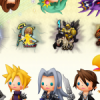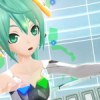Theatrhythm Final Fantasy: Curtain Call’s biggest achievement is providing a textbook example of how not to do a music-and-rhythm game. That’s not to say it’s a bad game, but it’s saddled with being rhythmically challenged whilst offering little rhythmic challenge of its own. It’s a rickety game built on pandering fandom and underpinned by a poor understanding of how player input and audio-visual game elements are supposed to ameliorate into a rhythmic experience the player can feel.
It’s intentionally put together so those with two left-hands can jump into tapping away to scores of tunes from across the Final Fantasy series. Cute-tastic chibi-artwork is sure to elicit squeals of delight from series fans, and it’s a premise so fantastic that it could sell what is still at heart a rudimentary music game. Except for one minor detail – it’s the exact same sales pitch we heard from the prequel, Theatrhythm Final Fantasy.
This is a problem, because Curtain Call hasn’t evolved in any meaningful way from its predecessor: The story briefly asserts itself as taking place canonically after the first game, a curious detail to expound upon as it then politely bows out, almost never to be heard from again. Maybe Square wants you to know you’re playing a sequel, and not that other Theatrhythm game.
Gameplay remains much the same - choose a song from the game’s extensive library, and you have to tap, hold and flick the stylus to on-screen prompts in something resembling the sensation of conducting an orchestra. Those songs come in three flavors: speedy battle music stages (BMS), the relatively sedate field music stages (FMS) and the timing-stringent event music stages (EMS) which play to illustrious vocal tracks from the series. The 200-strong track list (most of which unlocks just minutes into the game) is split almost evenly between BMS and FMS songs - with only around a dozen EMS songs in the entire game.
Clearing songs will earn you Rhythmia points, with unlocks dealt out at certain milestones, such as new songs and colored crystals - which contribute towards unlocking new characters. Those intent on unlocking new characters however, will find their attention best turned away from Music Select mode to Curtain Call’s other major attraction: Quest Medley mode.
Quest Medley tasks players with crossing through points on a map – at each stop, one of a select assortment of BMS/FMS songs need to be cleared - before reaching and defeating a boss for a handful of colored crystals. The catch is that your lifebar, which is shared between your 4 party members, carries over between songs.
And this is where things fall apart. Unlike Music Select mode, which gives the player almost unfettered access to Basic, Expert and Ultimate difficulty settings (the latter two named exaggeratedly), Quest Medley starts out on the sleep-inducingly easy Basic. It takes close to 20 hours for Ultimate mode songs to begin appearing in drips and drabs, and another 10 before map-wide stops are set to Ultimate difficulty. This forces you to choose between the challenge of Music Select, or making progress in the mind-numbingly easy Quest Medley.
Music Select mode presents a slightly stiffer challenge, but Curtain Call is easy even when jumping into a song at Ultimate difficulty. Make no mistake, there’s a difficulty curve in learning how to quickly and accurately perform flick gestures, but other than that Curtain Call offers little challenge. Fan familiarity with the track list is partly to blame - despite being the game’s main selling point - but a lot of it comes down to some questionable design choices.
Good rhythm games are built so it’s possible to play to songs initially using the visual aids of on-screen icons and button prompts, before upping the difficulty and forcing increased reliance on audio-memory to correctly time inputs. Curtain Call’s designers seem to grasp this point, but only superficially.
In both BMS and FMS songs, icons run down a lane towards player at a set, uniform pace. This pace changes between songs but not within them. The regularity of on-screen prompts allows players to effectively play deaf, hitting dozens of notes correctly even if they can’t discern which part of the song they’re playing to. This happens in BMS stages often, as the transition between melody and rhythm can happen suddenly without the player realizing. The uncanny sensation of tapping to icons whilst Final Fantasy music plays in the background, rather than tapping to the music itself sets in, creating a disconnect.
Grossly generous timing windows exacerbate this, abetting sloppy play. Even if an icon is half outside the target zone, it will still register as a Critical Hit. Erroneously playing to melody instead of rhythm (or vice versa) is unlikely to get the player into trouble, given that the two go hand-in-hand. The result: tapping to the wrong part of the song will often still count as a successful hit, but simply at a lower hit-timing rating. It’s yet another area where rhythmic prowess is overruled and players under-challenged.
FMS stages feel better as icons run toward the player in single file as opposed to the four lane style found in BMS songs. This single-lane design allows clear delineation between rhythm (taps) and melody (holds); giving the player a greater sense of connection with the music through their input. Unsurprisingly, the one-lane Feature Zones - which make up part of the BMS songs - also share this strength. The hold inputs in FMS songs require the player to jiggle the stylus up and down as they trace the crests and falls of the on-screen prompt. It’s the one area where small reverberations and delicate fluctuations in songs are picked up and reflected by player input – as a bonus, moving the stylus up-and-down replicates the sensation of skipping across a field, something mirrored by the on-screen avatars’ actions. But it also reduces the number of variables the player has to account for, and the lenient hit-timing found in BMS songs is present here too, limiting challenge.
The small selection of EMS songs are an exception, as timing is strict and hitting notes correctly requires pre-emptive input to overcome the wildly varying speed of the visual aids – essentially forcing play by ear. Curtain Call still attempts to play with the reliability of visual aids in BMS/FMS songs in Quest Medley by occasionally rotating arrows to keep the player guessing until the last second. But instead of being weaned off the visual and onto the aural, players remain certain of timing because of the uniform speed of incoming prompts. It’s a poor design choice that reduces the reliability of visual aids by obscuring input rather than input timing.
If you’re intent on eking out any challenge from this game, skipping Quest Medley is highly advised. Characters can still be unlocked (albeit at glacial pace) in Music Select, and the best unlocks are tied to Rhythmia count rather than item acquisition, making Quest Medley that much more unattractive. The juiciest unlocks by far are the Chocobo Dungeon tracks: intense high-speed remixes of classic tunes like Clash on the Big Bridge.
Given that each Quest Medley map is simply a different arrangement of BMS/FMS songs, you’ll find that once you’ve played one you’ve played them all. Quest Medley is simply Music Select mode in decorative, difficulty-locked packaging. The same is true of the “Collecta Crystarium” feature, which allows you to power up characters using combinations of character and enemy themed cards, a decorative feature we never felt the need to touch.
All of this begs the question, who is Curtain Call for? Certainly not dedicated rhythm junkies - it doesn’t hold the long-term appeal or challenge for them. And not for Final Fantasy fans, as the original Theatrhythm has them covered (albeit with a slimmer track list). Given that many of the songs here appeared in the first game it might be best to think of Curtain Call as a economy-priced bumper DLC set, likely to appeal to those who were so enthused with the original that they want more, yet (somehow) not enthused enough to have paid for the DLC. We’re not sure how many of those people exist.
Theatrhythm Final Fantasy: Curtain Call is a basic rhythm game tied to a Behemoth-sized IP. It has a staggering amount of content, but player skill level is likely to far outstrip the difficulty curve, leaving you bored and patronized a dozen hours in. It’s a long-term investment more than a long-term challenge, and its reliance on nostalgia-driven fan service calls into question whether a market even exists for it when the original ticks all the same boxes.








